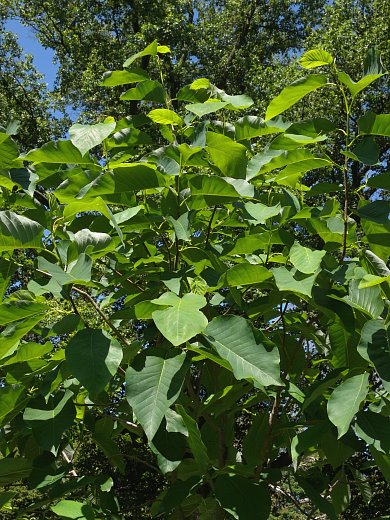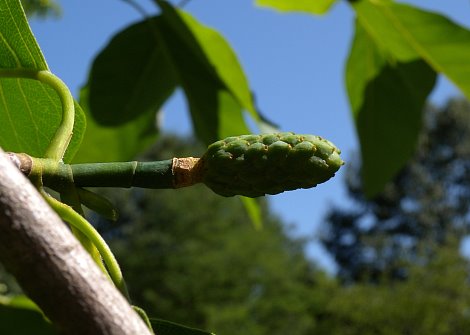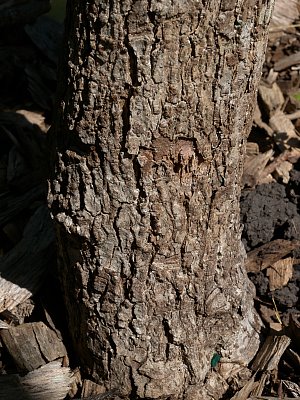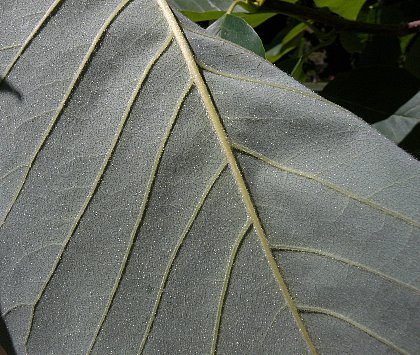
Flowers are produced individually at the tips of twigs, usually within the middle to upper crown of the tree. Each flower is 2-3½" long and a little less across, consisting of 6 yellowish green petals, 3 light green sepals, and a cylindrical cluster of pistils with a ring of flat stamens at its base. The petals are erect, oblanceolate in shape, rather leathery in texture, and often glaucous. The sepals are much smaller than the petals, drooping, and early-deciduous. The blooming period occurs from mid- to late spring as the vernal leaves develop. The flowers are slightly fragrant. Afterwards, cross-pollinated flowers produce compound fruits that are 1½-3" long, oblongloid in shape, and glabrous. Immature compound fruits are green and scaly in appearance, while mature compound fruits are orange-red to red and more irregularly shaped. There are typically 10-60 fruits per compound fruit, although many fruits may fail to develop. During late summer or autumn, these fruits become mature and release their seeds. Each fruit consists of a follicle that splits open along one side to release 1 or 2 seeds. Individual seeds are about ½" long and ovoid in shape; they have soft outer coats that are red or orange-red, fleshy, and oily. The ripe seeds are suspended from the compound fruit by thread-like structures before they fall to the ground. The root system is widely spreading and relatively deep; a taproot is rarely formed. Smaller roots are rather fleshy and delicate. This tree reproduces by reseeding itself. The deciduous leaves become dull yellow or brown during the autumn.

Cultivation: The environmental preference is full or partial sun, mesic conditions, and deep well-drained soil that is slightly acidic. The seeds should be kept moist during their winter dormancy, otherwise they will lose viability. Seedlings of this tree tend to more sensitive to adverse temperature and moisture conditions than those of other trees. Because of the delicate root system, this tree can be difficult to transplant. Once it becomes established, however, the rate of growth is rapid. Mature trees typically live for about 100-150 years. The relatively soft branches are prone to breakage and the entire tree can be wind-thrown, particularly on slopes. This tree can be successfully cultivated north of its area of natural occurrence; it is hardy to Zone 4. It should be planted in sheltered areas that provide some protection from high winds and late frost.

Range & Habitat: The native Cucumber Tree is restricted to southern Illinois, where it is rare (see Distribution Map). Illinois lies to the west and northwest of its primary range in the Appalachian mountains. Habitats consist of rich mesic woodlands, lower wooded slopes, wooded areas in river valleys, and wooded areas along streambanks above the flood zone. In Illinois, Cucumber Tree can occur in either oak-hickory or beech-maple woodlands. Outside of the state, it is sometimes found in mixed woodlands (both coniferous and deciduous trees). Because of its thin bark, this tree is easily killed by wildfires. It is sometimes cultivated as a landscape tree in gardens and parks.
Faunal Associations: Insects are responsible for cross-pollination of the flowers. Only pollen is offered as a floral reward to such visitors. Like other Magnolia spp., the flowers of Cucumber Tree are cross-pollinated primarily by sap beetles (Nitulidae) and other beetles. In the absence of such cross-pollination, the fruits of this tree will fail to develop. Insects that feed on the sap, foliage, and other parts of this tree are few in number. They include Neolecanium cornuparum (Magnolia Scale), other scale insects, Phyllocnistis magnoliella (Magnolia Leaf Beetle), and other leaf beetles. The bright red seeds are eaten by grackles and other forest birds, while deer sometimes browse on the twigs, leaves, and buds.

Photographic Location: Carle Park in Urbana, Illinois.
Comments: Among the native Magnolia spp. in North America, this is the tallest and most cold-hardy species. The Cucumber Tree has large attractive leaves, but its yellowish green flowers are less showy than those of other species in this genus. It is the only native magnolia in Illinois; the ranges of other magnolia species from North America are located south and southeast of the state. Some shrubby species of magnolias from east Asia are often cultivated for their showy flowers. These latter magnolias have white or pink flowers, rather than yellowish green. Because of its large size, the wood of Cucumber Tree has been used to make crates, boxes, fixtures, interior trim, cheap furniture, plywood, and other wooden items. The wood is light-weight, rather soft, straight-grained, and light brown. It has properties that are similar to the wood of Tulip Tree (Liriodendron tulipifera).